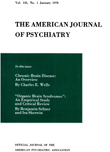PSYCHIC INGREDIENTS OF VARIOUS PERSONALITY TYPES
Abstract
The usual method of validating psychological tests by comparing them with clinically-defined psychiatric categories has been reversed. Instead, various personality types bearing psychiatric labels have been assessed by means of symbol patterns. A few examples have been given to illustrate the method. Superior normals are found to excel in creative imagination. Neurotics appear to be only partially emancipated from the stimuli of objects. Persons with characterological personalities appear to have been fixated at a pre-adolescent level of symbol perception. Schizophrenics use symbols autistically. And deteriorated organic patients show a lack of capacity to deal symbolically with their environment except on a concrete and unimaginative level.
These findings are not new and are readily accepted by persons familiar with mental patients. Yet it is interesting that we were able to distinguish the different psychiatric categories by means of symbol patterns found typical of the various disease groups.
Access content
To read the fulltext, please use one of the options below to sign in or purchase access.- Personal login
- Institutional Login
- Sign in via OpenAthens
- Register for access
-
Please login/register if you wish to pair your device and check access availability.
Not a subscriber?
PsychiatryOnline subscription options offer access to the DSM-5 library, books, journals, CME, and patient resources. This all-in-one virtual library provides psychiatrists and mental health professionals with key resources for diagnosis, treatment, research, and professional development.
Need more help? PsychiatryOnline Customer Service may be reached by emailing [email protected] or by calling 800-368-5777 (in the U.S.) or 703-907-7322 (outside the U.S.).



